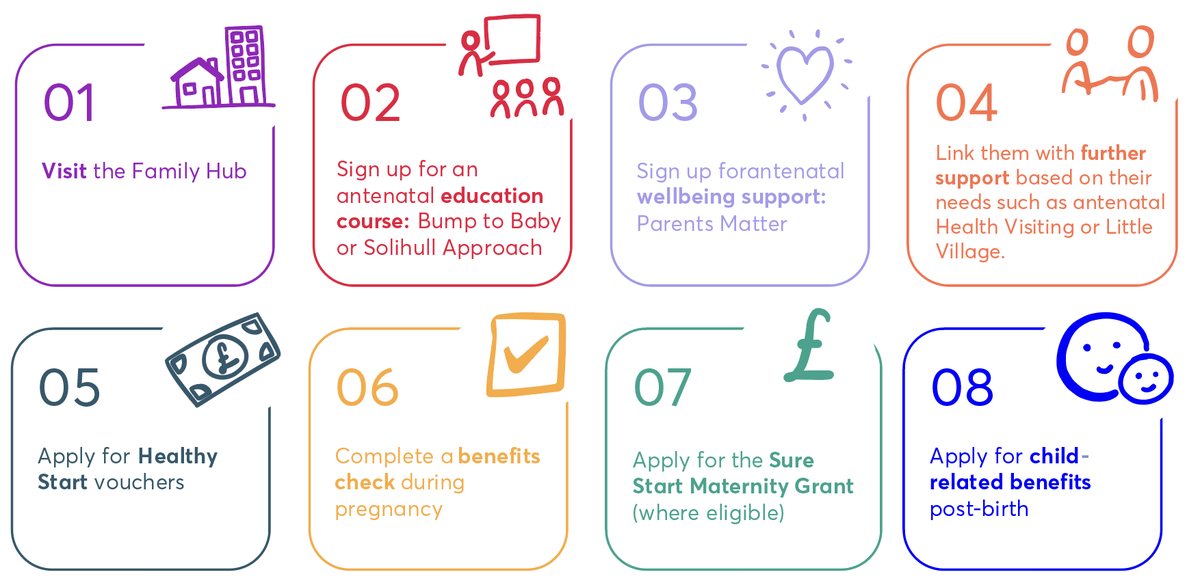Part 2: Family Navigator
“I want to say a massive thank you for helping me [...] your kindness, empathy, and the warm way you approached everything really made a difference to me [...] I’ll definitely be making the most of the information and courses you shared with me, and if I need any more support, I won’t hesitate to reach out.”
What is it?
The Family Hubs Pregnancy Grant Navigator (Family Navigator) is an outreach worker based within Camden Council. The Family Navigator proactively contacts parents eligible for the Family Hubs Pregnancy Grant, ensures they have received the grant and offers information and support to access a range of other services. This includes welfare advice, birth and parenting preparation, and access to practical baby essentials such as clothing and beds. The conversation guide that Family Navigators follow when contacting parents is available in the Navigator conversation guide.
Rationale
Why provide a proactive outreach with information on available services?
While Camden’s Family Hubs are widely accessed by over 80% of local families, we know that the least accessed services on offer are antenatal programmes. When we speak to parents, we commonly hear how they wish they’d known about what was available earlier, or during previous pregnancies. We also know that at least 15% of families living in the most deprived neighbourhoods aren’t engaging with Family Hubs at all. We wanted to find ways to reach them better.
There are many support services available, but it can be difficult for parents to navigate the information and understand what is right for them. Providing personalised, one-on-one support makes this more manageable.
The Family Navigator also provides a warm introduction to broader council services. A key service Family Navigators can signpost families to is welfare advice. People do not always access all the benefits they are entitled to, and so accessing welfare advice services could further boost the financial resources available to families. This may be particularly useful during pregnancy and for families with young children, as benefit eligibility changes with the birth of a child.
Why a phone call and a visit?
Just as we know from our research that it’s important to offer the cash grant through different means of communication, we knew that it would be important for Family Navigators to have multiple ways of engaging parents. A quick initial phone call carries the same ease of access, optional uptake and friendly, supportive tone that the grant was designed to have. Being able to offer a follow-up visit to the Family Hub provides support for people to overcome any feelings of being intimidated or nervous about engaging with a new place and new people.
Tailoring the visits to parents’ needs and schedules also helps them feel that this is a personal and dedicated support offer for them, and it allows them to better express what they are interested in or feel they would appreciate support with. Multiple one-to-one interactions with the same Family Navigator allows a relationship to be built, which in turn creates the right opportunities for families to share if they are feeling stressed or low about any aspect of their pregnancies, and the Family Navigators are then well placed to help them manage the wide landscape of different support on offer.
Key considerations in Camden
Understand what outreach and engagement services already exist
The goal of Family Navigators is to present a cohesive offer to parents engaging with services, so as a minimum, it is vital to know what other outreach offers families may be receiving. There were no proactive outreach offers to the pilot’s specific population of pregnant people in receipt of benefits. However, the Family Hubs already have Information and Engagement Workers (IEWs), who provide an important service to families once their baby is born. The Family Hubs Pregnancy Grant team worked with the IEW team to ensure continuity of the two offers and that the extensive expertise of the IEWs was the basis for the new Family Navigators.
Defining our eligibility criteria
The Family Navigator offer had the same eligibility criteria as the Family Hubs Pregnancy Grant (see Part 1). However, it was agreed that the Family Navigator offer would be randomised to half the eligible population. This decision was taken due to resource constraints that made it unlikely that all eligible families could be contacted anyway, so there was an opportunity to randomise this resource allocation to facilitate evaluation.
If you are in a similar situation, consider reviewing Nesta’s guidance on running randomised controlled trials in early-years settings.
Plan when the Family Navigator will contact families
In our pilot, Family Navigators are contacting families within a few days of their grants being offered and scheduling Family Hub visits for the following couple of weeks. This allows for a period of continued engagement where we can build on the initial excitement about the Family Hubs Pregnancy Grant to encourage further engagement. It also means Family Navigators can act as a point of contact to troubleshoot any issues with accessing the cash, saving on further administrative resources.
The timing of this offer also took into consideration the stages of pregnancy. With grants being offered a few weeks after the 20-week scan (roughly around 28-30 weeks), we wanted to make sure Family Navigators reached out to parents early enough that encouraging them to a Family Hub visit would not coincide with the very end of their pregnancy, where there was a chance they could be put off by the travelling required, and so they would be welcomed into a Family Hub with enough time to still make the most of the antenatal offers available.
We also knew that, even if parents engaged with Family Hubs in this period of focused activity, there was a chance this engagement would drop off towards the end of their pregnancy, particularly for those who were not interested in antenatal offers. To bridge this potential drop in engagement, we worked closely with the IEWs and created a personalised handover and transition for after their baby arrives. The Family Navigator uses the Family Hub visit as an opportunity to introduce parents to an IEW. The IEW then also becomes a trusted and recognised contact and reaches out to parents post-birth, re-inviting them to the Family Hubs and reminding them of the offers available to them now they have their babies.
Selecting a core offer
We spent a lot of time understanding the existing offers to families antenatally, analysing service capacity, purposes and the target users of different programmes.
Working closely with our colleagues delivering these offers, we condensed our priority offers to include one main service offer for each category of outcomes. For example, we selected one antenatal class, one mental wellbeing programme, one service for accessing baby essentials, etc. This meant that we could train Family Navigators quickly and make sure they, or the parents they interacted with, weren’t overwhelmed by the nuance of different offers. It’s important to do this narrowing down in close collaboration with early years teams, who hold the best knowledge of each programme and the different strengths and capacity of each.
We made sure that all the programmes included in our core offer would be available to all or most grant recipients, so further eligibility wasn’t an issue. By condensing our core offer to eight elements (see the outcomes one-pager), we could also evaluate the impact of the Family Navigator contacts by quickly capturing the engagement with each of the eight core elements we selected.
Develop the engagement offer
Once we understood who the offer was for and what we wanted to prioritise offering to them, we developed the implementation plan for the Family Navigators. This included recruiting the Family Navigators, who were appointed to this role alongside their existing work as financial support coordinators within the financial support service. We selected these staff, rather than early years professionals, partly due to capacity in the different teams. Additionally, we wanted our Family Navigators to be able to offer the targeted welfare advice and support that many parents needed, and this group of staff was already highly skilled in that area.
Ultimately, the role of a Family Navigator can be created from different settings, and there is not necessarily a need for a new and dedicated role to be created to deliver this kind of pilot. The essential skills for a Family Navigator are relational skills, safeguarding training and knowledge of the local offer. We worked closely with early years teams to train our Family Navigators in the nuances of our Family Hubs offers.
Training our Family Navigators to be able to have a level of fluency on both sides of the offer – antenatal and Family Hub services, and financial support – was the key element that made this a strong role. Our Family Navigators also bring personal strengths to the role, too – for instance, their experiences as parents themselves and as users of Family Hubs, as well as being fluent in other languages to support engagement with our diverse communities.
Alongside the core offer, we developed the script and call procedure, as well as the in-person meeting guide, for the Family Navigators to follow during their contacts, creating a clear checklist of the key parts of the offer they should mention and directing them to further resources if parents were interested in other things beyond this.
We created a data capture plan (see the data capture table for navigators) that outlined what information the Family Navigators needed to record about each of their contacts, and where and how to record this data. We also created a bank of template communications Family Navigators can use to follow up from appointments (see Navigator communications). These facilitated our process monitoring and contributed to our wider evaluation.
What to measure







